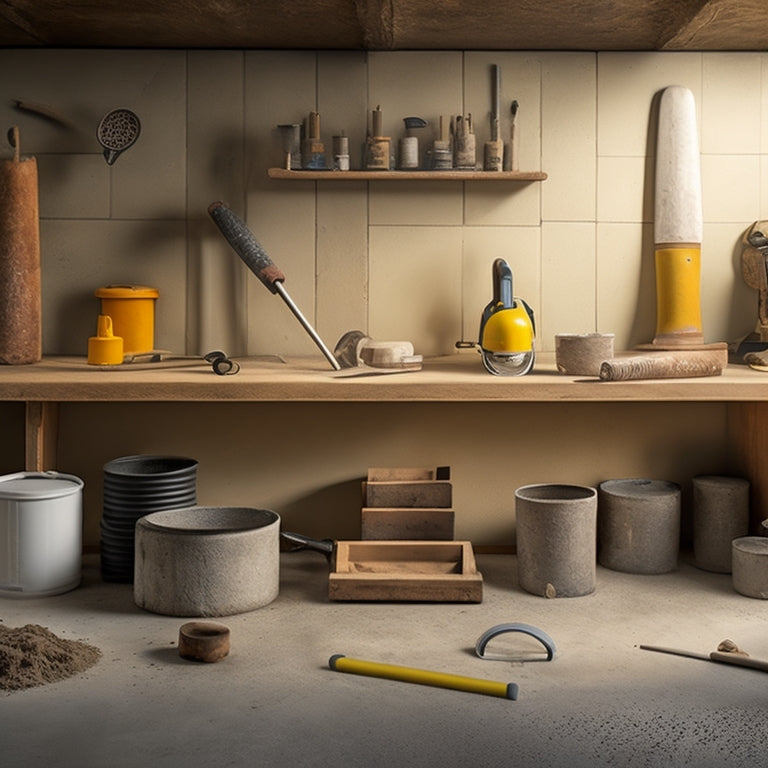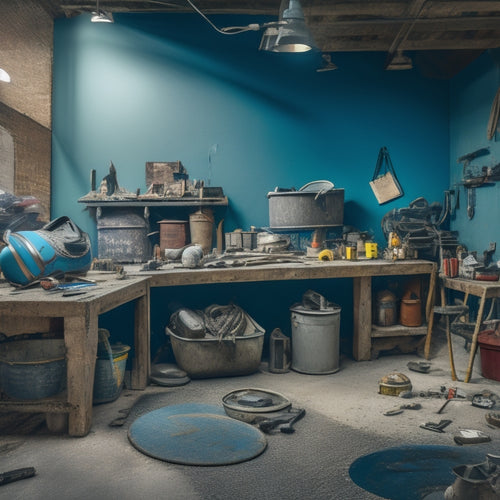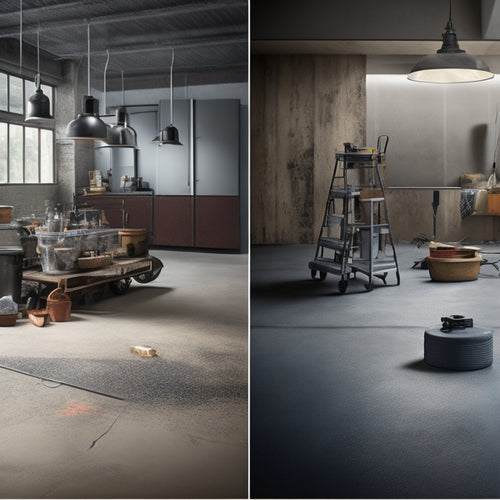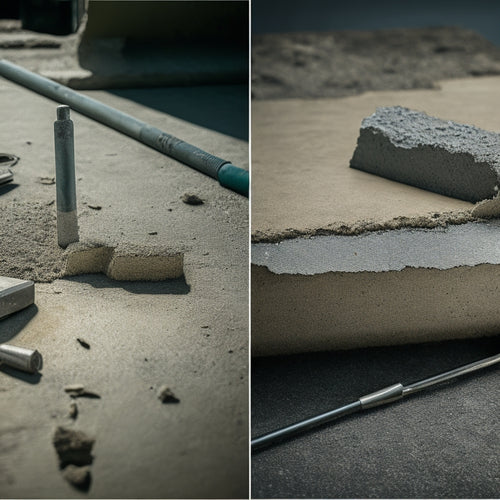
Top Concrete Screed Tools for Beginners to Own
Share
You'll need a range of concrete screed tools to produce high-quality slabs, and selecting the right ones is essential. Start with a screed board and handle that suits your project size and type, considering materials like aluminum or steel and adjustable handles for comfort. Next, choose the right screed blade type, such as aluminum, magnesium, or steel, and consider the length you need for efficient coverage. Don't forget important leveling tools like spirit levels, laser levels, and screed boards, as well as safety gear like goggles, masks, and gloves. With these basics covered, you'll be well on your way to mastering concrete screeding - and there's more to explore to take your skills to the next level.
Key Takeaways
• Invest in a versatile screed board suitable for small to medium-sized projects, made of lightweight aluminum or heavy-duty steel.
• Choose the right screed blade type, such as aluminum, magnesium, or steel, considering the project's size, concrete condition, and desired finish.
• Essential leveling tools include a spirit level, laser level, and screed board to ensure accurate concrete surface leveling.
• Start with basic smoothing and finishing tools like a bull float, darby or tamping tool, and a hand trowel for small areas.
• Prioritize safety with essential PPE like safety goggles, dust masks, steel-toed boots, and gloves to protect against screeding hazards.
Screed Board and Handle Options
You'll need a screed board and handle that suit your specific concrete pouring project, as they come in various sizes, materials, and configurations to accommodate different slabs, pours, and operator preferences.
Screed board materials range from lightweight aluminum to heavy-duty steel, each offering unique benefits regarding durability, weight, and cost. For instance, aluminum boards are ideal for smaller pours and DIY projects, while steel boards are better suited for large commercial projects requiring heavy-duty use.
When it comes to handles, adjustable designs are a must-have for peak performance. These handles allow you to customize the screed board's height and angle to fit your working style and the specific pour. Look for handles with sturdy construction, ergonomic grips, and smooth adjustment mechanisms to guarantee efficient and comfortable operation.
Essential Screed Blade Types
When pouring concrete, selecting the right screed blade type is vital, as it directly impacts the final finish and overall quality of the slab.
You need to take into account the screed blade materials, which typically include aluminum, magnesium, or steel. Each material has its strengths, with aluminum being lightweight and corrosion-resistant, magnesium offering superior strength-to-weight ratio, and steel providing maximum durability.
Blade length considerations are also important, as it affects the coverage area and the effort required to screed the concrete. A longer blade requires more effort but covers a larger area, while a shorter blade is easier to maneuver but covers less ground. Generally, a 6-8 feet long blade is a good starting point for most projects.
As a beginner, it's important to have a combination of screed blade types to tackle different projects and concrete conditions. Having a range of blade lengths and materials will give you the flexibility to adapt to various situations and achieve a high-quality finish.
Must-Have Screed Leveling Tools
Three essential screed leveling tools - a spirit level, a laser level, and a screed board - are important for achieving a perfectly level and even concrete surface. As a beginner, you'll need these tools to guarantee your concrete screed is accurate and precise.
Here's a breakdown of each tool and their benefits:
| Tool | Benefits |
|---|---|
| Spirit Level | Provides accurate leveling readings, ideal for small areas, and is a cost-effective option |
| Laser Level | Offers high accuracy, covers large areas, and is ideal for complex leveling tasks |
| Screed Board | Allows for efficient and even spreading of concrete, and helps to remove air pockets |
When using these tools, remember to follow proper leveling techniques, such as checking multiple points to verify accuracy and using a consistent reference point. Regular screed tool maintenance is also essential to maintain accuracy and extend the lifespan of your tools. By mastering these essential screed leveling tools, you'll be able to achieve professional-looking results and take your concrete screeding skills to the next level.
Concrete Smoothing and Finishing
Mastering the art of concrete smoothing and finishing requires a combination of the right techniques and tools to achieve a high-quality, defect-free surface.
You'll need to invest in a range of specialized tools to tackle this critical stage of the screeding process. To get started, you'll need a bull float, a tool used to remove excess water and even out the surface. Next, use a darby or tamping tool to compact the concrete and remove any air pockets.
Once the concrete has set, it's time to focus on finishing techniques. You'll need a power trowel or a walk-behind trowel to achieve a smooth, even finish. For more intricate areas, a hand trowel or edger will come in handy.
Don't forget to apply concrete curing techniques, such as applying a curing compound or using a concrete sealer, to protect the surface from damage and guarantee long-term durability.
Safety Gear for Screeding Work
You'll need to gear up with personal protective equipment (PPE) to safeguard yourself from the hazards inherent in screeding work, including eye damage, skin irritation, and respiratory problems. As a beginner, it's crucial to prioritize your safety and invest in the right gear to prevent injuries.
Here's a rundown of the must-have safety equipment for screeding work:
| Safety Equipment | Purpose | Recommended Brand |
|---|---|---|
| Safety Goggles | Protect eyes from debris and chemicals | 3M or DeWalt |
| Dust Mask | Filter out dust and airborne particles | 3M or Moldex |
| Steel-Toed Boots | Prevent foot injuries from heavy objects | Timberland or Dr. Martens |
| Gloves | Prevent skin irritation and abrasions | Mechanix or Carhartt |
Frequently Asked Questions
What Is the Ideal Temperature for Screeding Concrete?
When you're preparing to screed concrete, you need to take into account the ideal temperature. According to screeding temperature guidelines, the best range is between 50°F and 70°F (10°C and 21°C).
You'll achieve better results within this range, as the effects of temperature on concrete set time and strength are minimized. If it's too hot or cold, you'll face issues like rapid setting or weakened concrete.
You're in control, so make sure you're working within this sweet spot for a successful pour.
How Often Should I Clean My Screed Tools?
You know that downtime kills productivity, so prioritize screed tool maintenance.
Cleaning frequency is essential - you should clean your screed tools daily, or at least after each use.
Remove dried concrete with a wire brush, and wipe down tools with a solvent to prevent rust.
Regular cleaning prevents concrete buildup, ensuring your tools remain in top condition and extending their lifespan.
Can I Use a Screed Board on Uneven Surfaces?
You're wondering if you can use a screed board on uneven surfaces.
The answer is yes, but with some adjustments.
To maximize screed board effectiveness on uneven surfaces, you'll need to employ specialized techniques.
Start by identifying the low spots and filling them with a self-leveling compound.
Then, use a screed board with a longer handle to maintain even pressure, and work in smaller sections to guarantee a smooth finish.
Do I Need to Waterproof My Screed Tools?
You're wondering if you need to waterproof your screed tools. The answer is yes, you should.
Waterproofing your tools is an essential part of screed tool maintenance. It protects them from corrosion, extending their lifespan and ensuring peak performance.
By waterproofing, you'll prevent rust and damage from moisture, saving you time and money in the long run.
It's a simple step that pays off in the end.
Can I Rent Screed Tools Instead of Buying Them?
You're wondering if renting screed tools is a better option than buying them.
Let's debunk the myth that renting is always cheaper. While it's true you'll avoid upfront costs, you'll likely end up paying more in the long run.
Consider the screed tool benefits you'll miss out on, like having your own equipment tailored to your specific needs.
Renting may not provide the same level of quality or flexibility as owning.
Weigh the costs and convenience – buying might be the better investment for your concrete projects.
Conclusion
You've got the essential concrete screed tools covered! With these must-haves, you'll be well on your way to achieving a smooth, level finish.
Did you know that according to the American Concrete Institute, a single imperfection in a concrete slab can reduce its lifespan by up to 50%?
That's why investing in quality screed tools is vital. By following this guide, you'll be able to identify and correct imperfections, ensuring a durable and long-lasting concrete surface.
Related Posts
-

What Tools Do You Need for Concrete Flooring
You'll need a thorough arsenal of specialized tools to achieve a high-quality, professional-looking concrete floor, i...
-

Top Tools for Revamping Old Concrete Floors
You'll need a range of tools to revamp your old concrete floor, starting with epoxy, acrylic, or polyurethane paint, ...
-

Top Tools for Concrete Adhesion Success
When it comes to concrete adhesion success, you'll need to wield the right tools and techniques to guarantee a strong...


